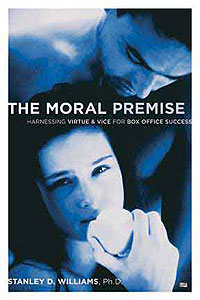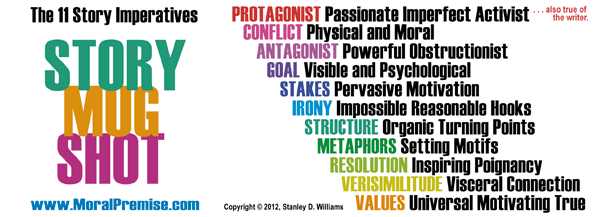
"The most powerful tool in my new tool box."
Will Smith
"A total game changer. The Moral Premise gets your story (and all your characters) working for you, instead of the other way around."
Michael Jann, Sr. Writer, Tonight Show with Jay Leno
"The Moral Premise dares to suggest that movies might actually mean something."
Chris Vogler, "The Writer's Journey"
"Thanks for the great book. I will recommend it to all my classes."
Blake Snyder, WGA, Author "Save the Cat"
"An incredibly practical and helpful tool that should be taught in every film school."
Marianne & Cormac Wibberley, WGA (National Treasure and National Treasure: Book of Secrets)
"Stan, You are a light and an incredible gift! Thank you for your insight and innovation.The Moral Premise: It's Amazing!"
DeVon Franklin, VP, Sony Entertainment
Author, "Produced by Faith."
"Should be required reading, retroactively, for every working Hollywood screenwriter."
Brian Bird, WGA, Producer
"Thank you, thank you, thank you for your wonderful Moral Premise, and for all you've done for me and my writing, Stan."
Tamera Alexander, Novelist
"This is really an important book."
Derek Rydall "The Script Doctor"
"Drop all of your 'to-do' lists, get this book, and curl up for the read of your screenwriting lifetime."
Dave Anderson, President, Compass Film Academy
Aspiring or working screenwriters - I have a tip for you. Buy the THE MORAL PREMISE by Stanley D. Williams and read it twice.
Paul Lalonde, Chairman, Cloud Ten Pictures
"More than a must-read; it is groundbreaking."
Curt LaLonde
More Endorsements >>
|
Story Mug Shot Mug Graphic
Below is a discussion of the Story Mug Shot graphic depicted below that also appears on our mugs. CLICK HERE to see the STORY MUG SHOT mug and other writing-aids.
You can order this mug at the Moral Premise Story Shop.

PURPOSE.
Listed on the mug graphic are eleven (in color) critical aspects of stories that connect with audiences, with modifiers (in black) that describe the key ingredients of the aspect.
PROTAGONIST.
The lead character must be passionate and actively toward his or her goal. Passive or characters that live interiorly with their thoughts are not good protagonists for a movie, or a novel.
CONFLICT.
The central physical and moral conflict that gives the story dramatic action. The inner-moral conflict and arc of the characters is what drives the outer-physical conflict. The conflict is principally between the protagonists and the antagonist.
ANTAGONIST.
The character in your story that forces your protagonist to change by putting powerful obstacles in the protagonist's path to prevent achieving the goal.
GOAL.
The PHYSICAL "want" that the protagonist must have at all costs, AND the PSYCHOLOGIAL "need" that the protagonists requires before achieving the want. Often the "want" is not fully understood by the protagonist at the beginning of the story. But the protagonist must strive toward it so clearly that the audience cheers him to success (in a redemptive story) or hopes that he fails (in a tragedy.)
STAKES.
Stakes are those terrible physical consequences that will befall the protagonist if the goal IS NOT achieved, or the consequences that will befall or prevail upon the antagonist if the protagonist's goal IS achieved. Consequently, the stakes are everywhere evident in the story (pervasive) and they motivate the protagonist to achieve it at all costs.
IRONY.
The best stories have deep, strong hooks. That means storytellers take an impossibility and make it reasonable.
STRUCTURE.
There is a natural order to telling and hearing stories. There must be turning points that dramatically shift the direction and focus of the story giving it interest, creating suspense, and keeping the audience interested is what's going to happen next. (See the multiple posts on the Moral Premise Blog HERE.)
METAHPORS.
Successful storytelling works because the audience is required to work and make meaning of the symbols created by the setting and motifs. Settings and motifs can be both visible and aural. Setting metaphors are ubiquitous. Motif metaphors occur in recurring beats.
RESOLUTION.
All successful stories have resolutions that can be redemptive, tragic, or a mix of the two. The best resolutions always have a touch of irony by reflecting reality of the human condition -- allowing the end to be both inspiring (uplifting) and poignant (cautionary) endings. In a redemptive story the poignant element may be understated. In a tragic story the inspiring element may be in the shadows.
VERISIMILITUDE.
For stories to connect emotionally with audience a strong visceral connection to reality is needed. The reality may take any number of forms, from gritty to visionary, from noir to fantasy. When filmmakers pull their punches and violate the general rules of the genre, verisimilitude is lessened, and the audience's expectations are lessened.
VALUES.
Underneath and supporting everything in a story's construction (even in the visual arts) is a conflict of values. One value (a virtue or strength) needs to be universally understood as true and motivating. This virtue or strength must be true to natural law and understood with little explanation to the audience. The other value (a vice or weakness) also needs to be universally understood as false and de-motivating. This vice or weakness must also be true to natural law and understood with little explanation to the audience. This conflict of dipolar or Nicomachean values is what the story is REALLY about, with the visual story the metaphor.
|





